13 Brunswick Square, servants from 1841 to 1940
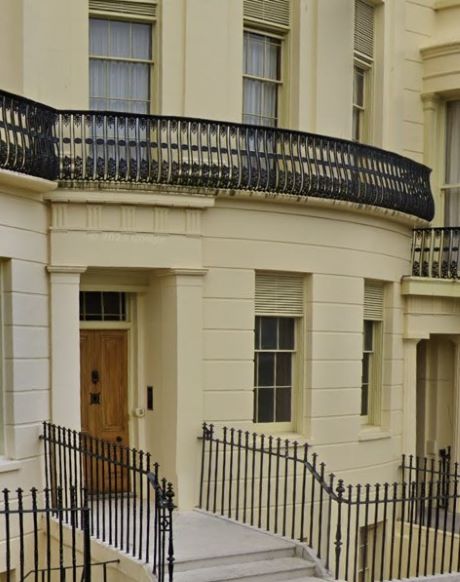
A Bit of Background
“Every nineteenth century family with social pretensions sought to employ at least one servant” - Pamela Horn, The Rise and Fall of the Victorian Servant, Sutton Publishing 2004.
Servants were seen as not only a necessity to aid the smooth running of a household but a way of defining social status. Indeed, the more servants a family employed, the greater their standing amongst their peers. Servants were signifiers of wealth.
The Regency Town house was no exception. The first 25 years of the house’s existence saw the comings and goings of numerous people who used it as a second home. Sometimes they brought their servants with them and at other times they employed local staff. The Kepps who had the house from 1857 until 1892 brought servants from their home in London and also employed local people.
Tracing servants is notoriously difficult with initially little to go on other than an entry in the census. However, there are some who it’s been possible to trace and they have some interesting stories to tell.
But firstly, let’s take a quick look at the roles of servants and what they may have expected to earn. This like everything else is not an exact science but will give a rough idea of their tasks and income.
The Butler is responsible for security, silver plate and glasses. He supervises wine deliveries, decanting and rebottling. He makes sure the table is correctly laid and supervises the serving of food. He could expect to earn £25 to £50 per annum.
A Footman acts as a valet to the master of the house, cleans boots and shoes, and takes care of oil lamps and candles. He attends to the family when they go out in a carriage. He can expect to earn £20 to £40 per annum.
The Housekeeper takes orders from the lady of the house and is responsible for organising the food shopping, household tasks and laundry. She can expect to earn £18 to £40 per annum.
A Housemaid is given all her tasks by the Housekeeper. One of her jobs is to get up earlier than the rest of the household to clean grates and light fires. She could earn £10 to £17 per annum.
The Cook like the Housekeeper takes her orders from the lady of the house. She supervises the cooking and delegates tasks to the kitchen staff. She can expect to earn £12 to £26 per annum.
Hopefully the above will give a flavour of what servants may be expected to do. Other roles might include coachman, groom, kitchen maid, parlour maid and maid of all work.
Salaries quoted are those recommended in 1861 when £1 was worth about £100 in today’s money.
Families could find servants in a number of ways. Many came as recommendations from other people.
Some servants advertised themselves as did Adeline Girard living at number 13 in 1856.

Brighton Gazette 16 October 1856
Others could be found through local agencies.
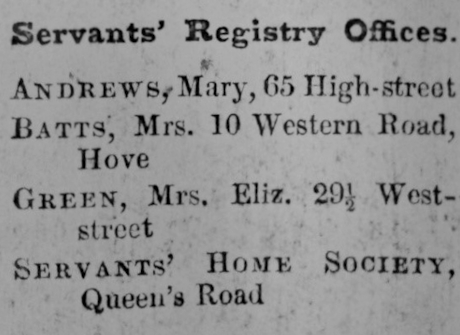
Folthorp’s Brighton Directory in 1850
Philanthropic organisations such as the Girl’s Industrial Home also trained and supplied servants.

W J Taylor Directory 1850
The Servants
Five servants are listed in the census taken in 1841. Sir Archibald Galloway was the head of house and even with his own children he often gave them the same age so it is unsurprising that the servants’ ages are remarkably similar. They were:-
James Twyman 25
Louisa Badcock 25
Susan Burston 24
Ellen Tompson 25
Marion White 24
The names are hard to read so the above is a best guess. They were all described as House Servants and none of them were born in Sussex and the 1841 census provides no clue to where they came from.
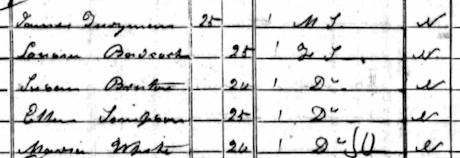
Census 1841 entry for the servants at number 13 Brunswick Square
Nothing was retrieved following extensive investigation about who they were and what happened to them.
The next investigation was a lot more forthcoming. In the 1851 census the house was described as unoccupied. However, sometimes servants are mentioned in the newspapers linked to an address and that is the case for William Colby.
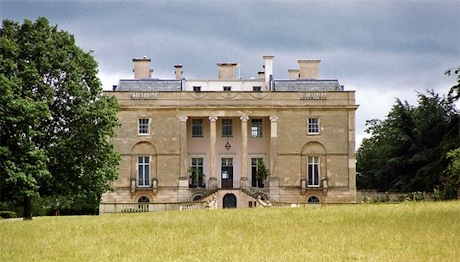
Bletchingdon House
Bletchingdon House is where in the 1851 census William Colby was working as a footman for Lord Valentia. Lord Valentia was a regular visitor to Brighton and in 1850 was at number 13 Brunswick Square when as reported in the Brighton Gazette a dead baby was found in the basement area of the house. It was shoemaker Charles Gillam who found the baby boy wrapped in a brown paper parcel. William Colby (althought the newspaper mispells his name as Colly) was questioned and he verified that he had locked the gate at 11.00 the previous night. No cause could be found for the infants death and no one claimed him. The mystery of who he was or how he came to be in the basement area of the house remained unsolved.
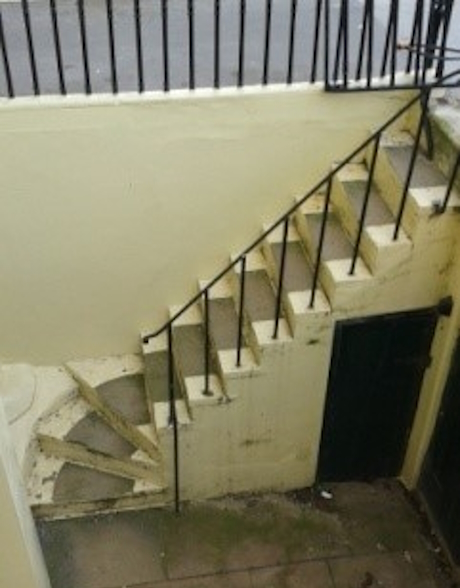
Basement area or number 13 where the baby was found
William Colby was born in Bletchingdon on 20 February 1831, his father was James and his mother Mary. The certificate states he was “privately received into the church on July 17th.

William Colby’s birth registration – 20 Feb 1831
He was just 19 when questioned regarding the dead baby and immediately after the 1851 census he disappears from view. However, in 1866 he shows up again working for the Post Office delivering mail and is arrested for stealing a letter bound for a Mr Bendy containing 48 postage stamps and a half sovereign. At his trial at the Old Bailey he intiallly claimed that his father James Colby of Bletchingdon had given him the letter but later pleaded guilty. He was sentenced to 5 years penal serivtude and removed to Portland Prison in Dorset. He serves his time being described in the quarterly returns as having “Exemplery” behaviour.
Portland Prison had very harsh conditions and there were numerous attempts to escape. In the 1860s three wardens were killed by prisoners. It was also in the 1860s that the prison started to house category-one Irish convicts of the “Fenian Brotherhood”.
In 1921 the prison became a Borstal for young offenders and is today a Young Offenders Institution. Read more about Portland Prison here.
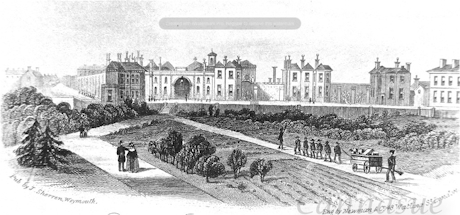
Portland Prison in 1868 when William Colby would have been incarcerated.
The Old Bailey court report mentions his wife Elizabeth and their address when he was arrested as being 6 Honiton Terrace, Blue Anchor Road, Bermondsey.
There is another gap in information until William and Elizabeth turn up in the 1881 census living at 2 Richmond Street, Newington, London. He is now 50 and Elizabeth is 57. He is working as a barman and it is here that the trail finally goes cold.
By the 1861 census the house is owned by the Kepp family and for the next thirty years they divided their time between their home at 15 Sussex Place London and number 13 Brunswick Square. Designed by John Nash, Sussex Place consisted of 26 terraced houses. The Kepps lived at number 15 and the building is now the London Business School.
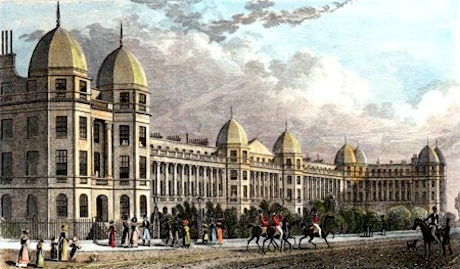
An engraving from 1828 of Sussex Place, Regents Park
It would appear that during that period some of their servants were local while others moved with them back and forth between the two addresses.
Let’s have a look at some of these servants in more detail. The 1861 census shows just two servants in residence at number 13: Louisa Mills and Elizabeth Wright.
Louisa Mills was born in Brighton and was 22 at the time of the 1861 census. Her father, Thomas Mills, was a fly and cab driver. In 1863 at St Nicolas Church, Brighton, Louisa married William Leonard Arnold a wheelwright from Henfield. Over the years a number of the servants who worked at number 13 Brunswick Square got married in the parish church of St Nicholas in Brighton.
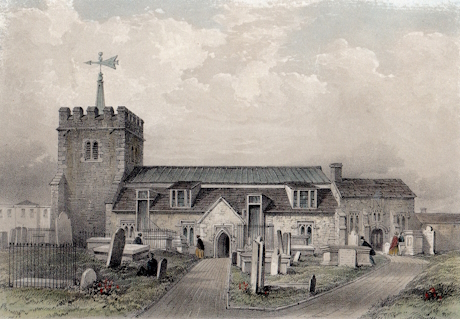
St Nicholas’ Church. Credit: The Regency Society Brighton Prints Collection
In 1871 the family was living at 47 Wood Street, Brighton with their son William aged 7. Louisa is working as a needlewoman.
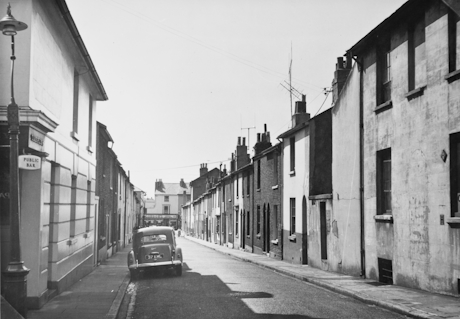
Wood Street in 1959. Credit: Regency Society James Gray Collection
Husband William Leonard died in 1878 just 39 years old and Louisa continued to live in Brighton. 1881 finds her living at 6 Saunders Buildings with two sons, Henry, an errand boy, and Edward, a scholar. Now she is a charwoman.
1891 the family are living at 29 Devonshire Place and Louisa is again working as a needlewoman. Son Henry is a groom and Edward is an agent for sewing machines, probably a handy job given his mother’s role. In 1901 they are again at a different address, 67 Toronto Terrace. Henry is now listed as the head of the house and at 36 is a private in the Sussex Hussars. The son aged 30 called Charles is the same age as Edward who has disappeared. Perhaps Edward changed his name but this son is listed as being a stage hand at the theatre.
Elizabeth Wright was born in 1835 in Great Hormead, Hertfordshire. In 1865 she married William Scrine at St Nicholas Church. He was 32 and Elizabeth was 30. Both are described on the marriage certificate as being servants. For over 20 years they ran a lodging house at 124 Kings Road, Brighton. It was presumably a rather fine establishment as a number of their guests are listed in the Brighton Gazette Fashionable Chronicles. William died in 1891 and left £364 13s (about £38,000 in today’s money) to Elizabeth who continued to run the lodging house at 124 Kings Road until she died in 1892 just a year after William.
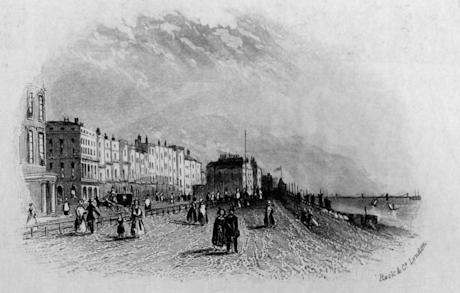
Kings Road Brighton, 1860s. Credit: The Regency Society Brighton Prints Collection
Edward Agnew worked for the Kepp family for many years starting out as a Page, advancing to Footman and finally in 1891 he is the Butler. Edward was born in 1843 in Watford, Hertfordshire, son of Andrew Agnew, a publican. In 1874 when 31 he married Mary Anne Hutchings aged 36 at the Parish Church in Hurstpierpoint. In the 1881 census Edward and Mary Anne are living at 12 Hampton Place, Brighton and he is working as a Lodging House Keeper. However, it seems possible that the business failed because in the 1891 census he has returned to working for the Kepp family as a Butler at number 15 Sussex Place and his wife Mary Ann as Housekeeper at number 13 Brunswick Square.
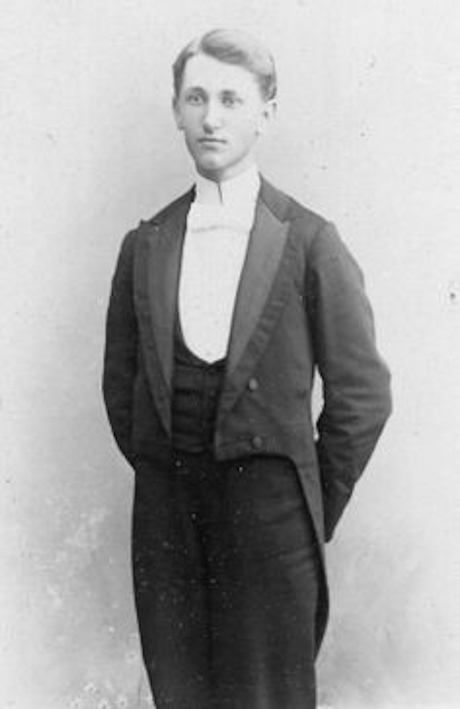
A butler in the 1890s in typical dress
In 1901 Edward is working as a Poultry Keeper in Lancing with Mary Anne who dies in 1904. However, a year later in Brighton he marries Ellen Louisa Camfield. He is 62 and she is 57. It is interesting to note that Ellen Louisa also worked for the Kepps and was at number 13 Brunswick Square in 1881. In 1891 she is working at the London address alongside Edward while his wife Mary Anne is at number 13. Was she a family friend before Mary Anne died or can we read an illicit love affair into the information? We will never know. In the 1911 census Edward and Ellen Louisa are at Roseneath, Farmers Lane Lancing where he is a poultry keeper and Ellen Louisa is letting apartments.
Edward died in 1922 leaving £459 8s 6d, about £21,000 in today’s money.
George Hounsell was born in Taunton, Somerset in 1830. In 1861 he is the Butler at 15 Sussex Place. In 1863 he married Amelia Barnes aged 21 in St Mary’s Church, Marylebone. They had two daughters: Ada in 1865 and Alice in 1868. In 1871 George is again at 15 Sussex Place and Amelia is a cook for Robert Capeman a carpenter/joiner at Milton Street, Marylebone where she is living with Ada aged 6 and Alice aged 3. By 1881 George and Amelia are together, both working for the Kepps. George is working at number 13 as a Butler while Amelia is Housekeeper along with daughters Ada and Alice at Sussex Place. Ada is 15 and Alice 13 and both are described as domestics.
At number 13 in 1871 the only residents are Jane Bell born 1842 in London and Mary Ann Starmer or Stainer born in Brighton in 1840. Mary Ann was also working at number 13 in 1881 while Jane was at the London house in that same year. There are no other references to the pair.
From 1892 the house was occupied by Willoughby Furner and his wife Ada. In the 1901 census five servants are listed:
Agnes Clairy aged 25, a cook born in Whitstable, Kent
Ellen Walker aged 38, a housemaid born in Buckinghamshire
Rhoda Ruff aged 37, a Parlour Maid born in Oving, Sussex
Mary White aged 33, a housemaid born in London
May Sedgewick 17, a housemaid born in Putney, Middlesex
Let’s see who they were.
Agnes Kate Clary (without the i) was born in 1876 in Whitstable, Kent, the daughter of Ebeneza, a shipwright from Bury St Edmunds, and Sarah Ann. In the 1891 census Agnes has temporarily dropped the Agnes and is registered as Kate Clary. At 17 and perhaps no different from any teenager she wanted to stake a claim and identify with a different name. She is working at a Rectory in Combs Suffolk as a kitchen maid. By 1901 at number 13 she has reclaimed Agnes and the Kate is missing.
Agnes Kate married Frank Morley a baker in 1906 at All Souls Church Brighton. He is 33 and she is 31. At the time of the marriage the pair are living at 46 Essex Street, Brighton. In 1909 the couple have a daughter and whatever Agnes Kate felt about her first name she called her child Agnes Maud Clary Morley. At the time they are living at 43 St Lukes Terrace and Frank describes himself as a Confectioner.
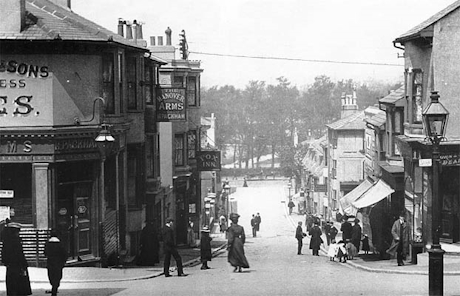
Southover Street in 1910
There are references to a number of bakeries in Brighton in the late 19th to early 20th centuries: Goldsmiths 90 Southover Street, Thomsons Scotch Bakeries King Street, Grooms in Sutherland Road (in the ‘60s folk remember Bute St, Rochester St and Hendon St being referred to as “Bakers Bottom” because of Grooms Bakery up the hill!!) Did Frank work for any of these? We don’t know but there clearly a number of employment opportunities for him.
Frank was born in Brighton and his father Alfred was also a baker. By 1911 the family are living at 32 Freshfield Street and Frank is describing himself as a Biscuit Baker. Agnes Kate dies in 1918 aged just 41.
Ellen Walker born in 1863 in Fenny Stratford, Buckinghamshire, appears to be a loyal employee being with the Furners for at least 10 years. In 1891 she is working for them at 2 Brunswick Place (their address before they moved to number 13). However after finding her in the 1901 census at number 13 she disappears.
Information about Rhoda Ruff is a bit more forthcoming, probably because her name is rather unusual and she didn’t marry.
Rhoda was born in Oving, West Sussex and was baptised on 7th July 1863. Her father was Francis, a gardener and her mother Hannah. Rhoda appears to have moved around for work in the Brighton area. In 1881 aged 18 she is working for Harry N. Sharp a 22-year-old member of the Stock Exchange and living at 42 St Aubyns, Hove. There are two other servants besides Rhoda who is listed as a Housemaid. Interestingly although Harry is described as the head of house the property in fact belongs to John Tooth his future father-in-law.
In 1891 Rhoda is one of nine servants working for James Fairs a 62-year-old widower described as living on his own means at 9 and 10 St Catherines Terrace Hove. As with all the others she is described as a Domestic Servant apart from one who is a Hospital Nurse. Rhoda is 27.
In 1901 Rhoda is working as a Parlour Maid at number 13 Brunswick Square. 10 years later in 1911 she has moved to Lewes and is working for Lady Caroline Charlotte Ramsey at Owsden House. Lady Caroline, the widow of Alexander Entwistle Ramsay, was born in Owsden, Suffolk. It’s interesting that she named her house after the place that she was born.
Still a Parlourmaid, Rhoda is 47. Caroline died in 1913 leaving £19,958 10s 9d, nearly two million pounds in today’s money.
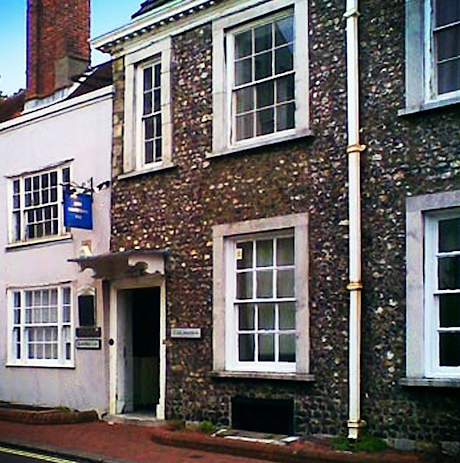
Owsden House in Lewes, now the Con Club a popular bar and music venue
In the 1921 census Rhoda is living at 17 Coventry Street, Brighton. She is 58 and working as a domestic at “no fixed place”, probably meaning that she is working for a number of people. Rhoda continues appearing in the Electoral Register living at number 17 Coventry Street during the 1920s. She stays in the Seven Dials area, also living at 29 West Hill Road and finally in Prestonville Road, where she dies in 1949 aged 85.
Mary White, aged 33 born in Middlesex, is a Housemaid. Unfortunately there is no further information about Mary.
May Sedgewick, aged 17, is a Housemaid born in Putney. Like Mary White nothing could be tracked down for May.
There is no census return in 1911 for number 13. However, Willoughby Furner is on the electoral register in that year as living at the house. For the 1911 census the Furners are listed as resident at 22 The Drive, Hove with three servants.
Arundel House, 22 The Drive, Hove is a four-storey block of flats constructed in 1898 in a Free Jacobean style. Willoughby and Ada (his wife) were at flat number one.
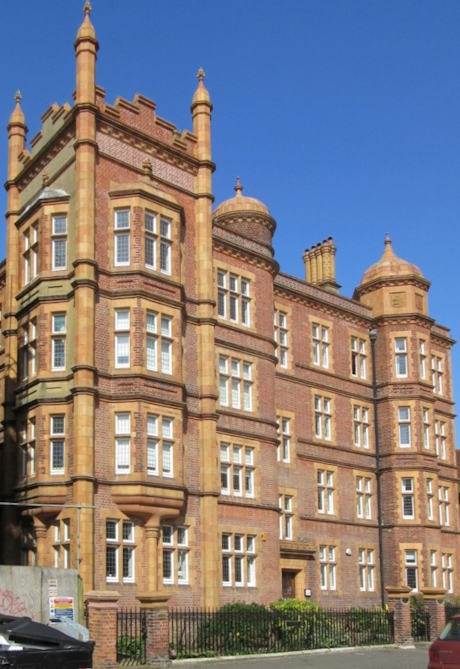
Arundel House 22 The Drive, Hove
Perhaps the Furners owned both properties and were at the Drive because work was being done on number 13. Whatever the reason, for the purposes of this research the three servants present at 22 The Drive are included in this article.
Mary Ellen Kenward was born in Brighton in 1866. In the 1871 census she is five years old and living at 5 St Peters Street with her father Charles Kenward aged 30 and her mother Mary 33.
In 1881, aged 15, Mary Ellen is described as unemployed. The family are now at 7 St Peters Street. And her father is a shoemaker and there are seven children including Mary Ellen.
At the age of 25 in the 1891 census Mary Ellen is working as a parlour maid at Franklands, Keymer Road, Keymer. There are only the four servants present at the time. Ten years later in 1901 she is still at Franklands working as a parlourmaid and she is now 35. Mary E Jenkins aged 78 is the head of the household. There are five servants including Mary Ellen.
In 1911 Mary Ellen is working for the Furners. On 20 June 1911 she gets married at St Nicholas Church to Charles Theodore Hetzel. She is 45 and he is 69. Initially there was some doubt as to whether it was in fact our Mary Ellen as on the marriage certificate her father is described as a deceased undertaker yet on most of the censuses he is said to be a shoemaker. However, when his daughter Agnes Annie was baptised in 1888, he is said to be an undertaker. Maybe he did both jobs or told lies - we will never know. However, regarding Mary Ellen’s marriage, I think we can be pretty sure this is correct as all the other details fit the bill.

Charles and Mary Ellen’s marriage certificate from 1911
Charles Theodore Hetzel was born in 1841 in Germany in the Duchy of Baden. He received his naturalisation certificate when he was 61 in 1901.
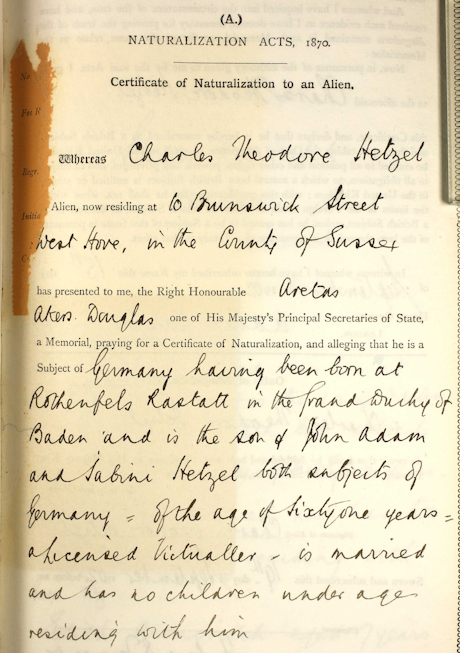
Charles Theodore Hetzel naturalisation certificate
Charles was first married in 1872 at St Nicholas Church, Brighton, to Amy Pinnel. He was 30 and she was 29. On the marriage certificate both are described as waiters. Amy died in 1908.
In the 1901 and 1911 census Charles Hetzel is a licensed victualler at the Star of Brunswick, Brunswick Street West. Find out more about the history of the pub here.
How did Mary Ellen and Charles meet? Perhaps she went to the Star of Brunswick for refreshments after work or perhaps Charles was a patient of Dr Furner?
Charles died in 1919 aged 78 at 42 Stafford Road, Brighton, and he left £659 18s, about £28,000 today, to his widow Mary Ellen. Mary Ellen continued to live at 42 Stafford Road until her death in 1948 at the age of 83.
Rose Ware was born in Hove in 1890 and was 21 at the time of the 1911 census working as a housemaid. Rose was one of six children, her parents being Sarah and Walter Ware. In 1891 the family were living at 35 Goldstone Road, Hove and Walter was working as a plasterer. Ten years later the family are still at 35 Goldstone Road where Walter is 50 as is Sarah his wife. There are six children including 11-year-old Rose. After the entry in the 1911 census there is no further trace of Rose.
Rebecca Barnes was born in Hambledon, Oxfordshire in 1880 and was the Furners’ cook in the 1911 census. Other than this census entry no trace can be found of her or her family.
In the 1921 census number 13 is occupied by two families. Dr John Richard Griffith is the head of one of them living with his wife Elsie Maud, two servants, Rose Terry and Maude Gertrude Sommers, and a visiting anaesthetist. The other family headed by Reginald Cardwell Barron doesn’t have any servants.
Rose Terry was born on 26 June 1895 in Greenwich. Her father was Thomas John Terry a labourer and her mother was Esther. In 1901 when Rose was six, they lived at 4 Bell Street, Greenwich.
In 1911 aged 15 she is working at 12 Ulundi Road, Blackheath as a parlour maid for retired hospital nurse Mary Elizabeth Dalton. Did Mary Elizabeth know Dr John Richard Griffith? Is that how Rose ended up at number 13 working as a servant in 1921?
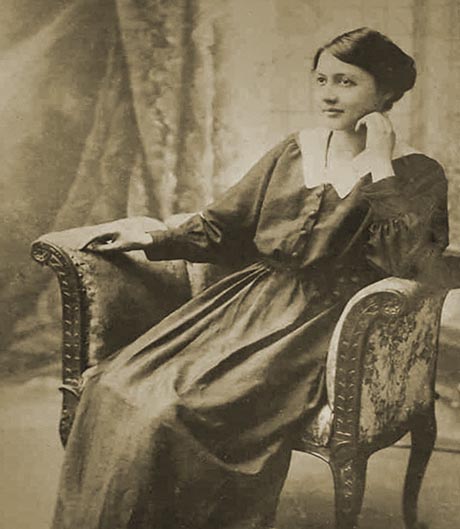
A young Rose Terry: photo kindly supplied by her great-grandson.
It was later the same year of the 1921 census that Rose got married in the Parish Church in Greenwich. Her new husband was Alfred James Fears, born in 1894, and he was a groom and gardener living at the time of the marriage at 23 Robertson Road, Preston Park, Brighton.
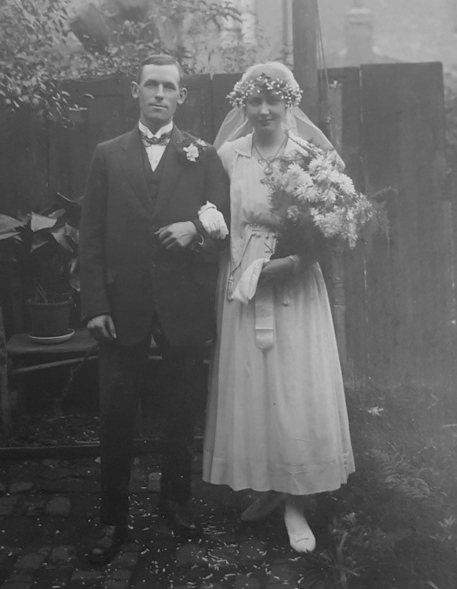
Alfred James Fears and Rose Terry on their wedding day 1921
In 1912 aged 18 Alfred enlisted as an Army Reservist and in 1914 at 20 re-enlists into the Army when his job was that of gasfitter, living at 23 Robertson Road. According to war records it appears he was a driver for the duration of the war.
In the 1939 register Alfred and Rose are living at 5 Newick Road, Brighton. Alfred is a Brewers drayman and Rose is doing unpaid domestic duties. Also living with them is their son Frederick aged 17, he is a Capstan Lathe worker. The couple had another son Charles Alfred who sadly died in December 1925 just six months old.
Rose died in Brighton General Hospital in 1962 aged 67 and Alfred in 1977 aged 83.
Maude Gertrude Sommers was born in Worthing in 1897. In 1901 she is with her parents George Stephen Sommers, a railway porter, and mother Alice Rhoda living at 4 Warwick Road, Worthing. In 1921 she is the cook at number 13 Brunswick Square. Later in 1928 she marries Walter Young in Edmonton, Essex. Walter is 10 years her senior having been born in 1887.
In the 1939 register she is living at 39 Page Street, Hendon with Walter, a postman. He dies in 1957 and it would appear at some point Maude returns to Sussex as she dies in Lancing in 1976 aged 79. She leaves £12,379 about £80,300 today in her will. Unfortunately, the probate record doesn’t state the beneficiaries.
John Richard Griffith and his wife Elsie Maud are still at 13 Brunswick Square in the 1939 register. One servant, Ida Frehner, a cook, born in Switzerland on 4 June 1920 is also present. Unfortunately, nothing more is known of Ida.
It is perhaps here that the age of the servant for number 13 Brunswick Square is over.
Unfortunately, not all of those who worked in the house over the years have been traceable but some have revealed details of their lives that give us an insight into their stories. We can perhaps imagine some of them reacting to the summoning bells, cleaning out grates, admonishing trades people and hopefully finding companionship and laughter below stairs as the grand owners in the drawing room drank tea and nibbled on fine cakes baked in the hot kitchen.
Research by Jill Vigus (September 2024)
Return to Brunswick Square page


